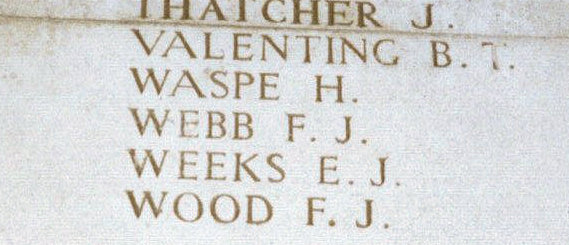Name
Frederick James Webb
1886
Conflict
First World War
Date of Death / Age
10/08/1917
31
Rank, Service Number & Service Details
Sergeant
G/4665
The Queen’s (Royal West Surrey Regiment)
7th Bn.
Awards: Service Medals/Honour Awards
1914 /15 Star, British War and Victory medals
Cemetery/Memorial: Name/Reference/Country
YPRES (MENIN GATE) MEMORIAL
Panel 11 - 13 and 14.
Belgium
Headstone Inscription
NA
UK & Other Memorials
Hitchin Town Memorial, St Mary's Church Roll of Honour (Book), Hitchin
Pre War
Frederick was born in 1886. Sources vary for the location but is most likely to be Worplesdon or Pitchplace – both near Guildford, Surrey. His parents were (Alvin) James and Ann Webb.
In 1891 the family were living at 4 Sparkes Row, York Street, Guildford. Present were both parents: James (47) and Annie (46), with James working as a groom. Their children were: John (17), Beatrice (13), Olive (11), Milla (8) and Frederick (5).
In 1901 the family were at same address, with James now working as a farmer’s stockman. Their children present were Annie (19, probably Milla above), Frederick, now 15 and a railway carman. Plus a grandson, Reginald (6).
Frederick married Florence Gritt (b 3/5/1885), on 13 April 1907 in St John’s Church, Surrey. By this date Frederick’s father had died.
By 1911 Frederick (25) and Florence (25) were living at 5 Margaret Road, Leas Rd Guildford, Surrey and had two sons Frederick James (b 22/10/1907) and Harold Jack (b 17/10/1909). Frederick was working as brewer’s drayman. The census recorded they had been married for 4 years with 2 children, both living.
It is believed that Frederick became a Police Constable in Hitchin and that the family lived at 91 Balmoral Road, Hitchin, Herts.
Officially he was recorded as born in Guildford, Surrey and was living in Hitchin when he enlisted there.
Wartime Service
He joined the 7th (Service) Battalion of the Regiment and was given the Regimental Number G/4665. This Battalion was one of the Kitchener Army Battalions and was formed in Guildford in September 1914. It landed at Boulogne on the 27 July 1915 and formed part of the 55th Brigade in the 18th Division of the II Corps in the 5th Army.
On the 26 September 1915 he was a private soldier and was wounded in the right shoulder and shoulder at Loos and was sent to the 16th Hospital at Le Treport. Then admitted to Alexandra Military Hospital, Millbank, London SW with wounds to his shoulder and chest on 30 September 1915 and was not discharged until 19 August 1916
After his recovery he re-joined the Battalion and within two years had been promoted to Serjeant and had taken part in various engagements. He was reported missing on the 10 August 1917 and in June 1918 it was confirmed that he had been killed in action.
On the 10 August 1917 he took part in the Third Battle of Ypres in the follow-up attacks after the Capture of Westhoek. The 7th Battalion had already been in the front line for a week and the men were exhausted. Nevertheless at 1.30am in the morning of the 10th August 1917 they were seen by German sentries crossing the morass of broken trees and mud to the ridge at Stirling Castle south east of Hooge. A little later the Battalion was attacking on a 400 yard front along the eastern edge of Inverness Copse but having been seen assembling, came under severe shell and machine-gun fire even before zero hour. This became so severe that they were likely to become enveloped and had to fall back as it proved impossible to send reinforcements to them. The casualties in just a few hours were severe with the loss of 10 officers and 272 other ranks which was more than a quarter of the fighting strength.
Additional Information
After his death £9 9s 9d pay owing was authorised to go to his widow, Florence, on 31 August 1918. Later, a war gratuity of £9 was authorised to be paid to her on 4 November 1919.
His pension cards record Florence Webb as his widow and as his dependant, living at 26 Balmoral Road, Hitchin. It also records their children as Frederick James (b 22/10/1907) and Harold Jack (b 17/10/1909). She was awarded a pension of 25s 5d a week from 15 April 1918.
Acknowledgments
Adrian Dunne, David C Baines, Jonty Wild



